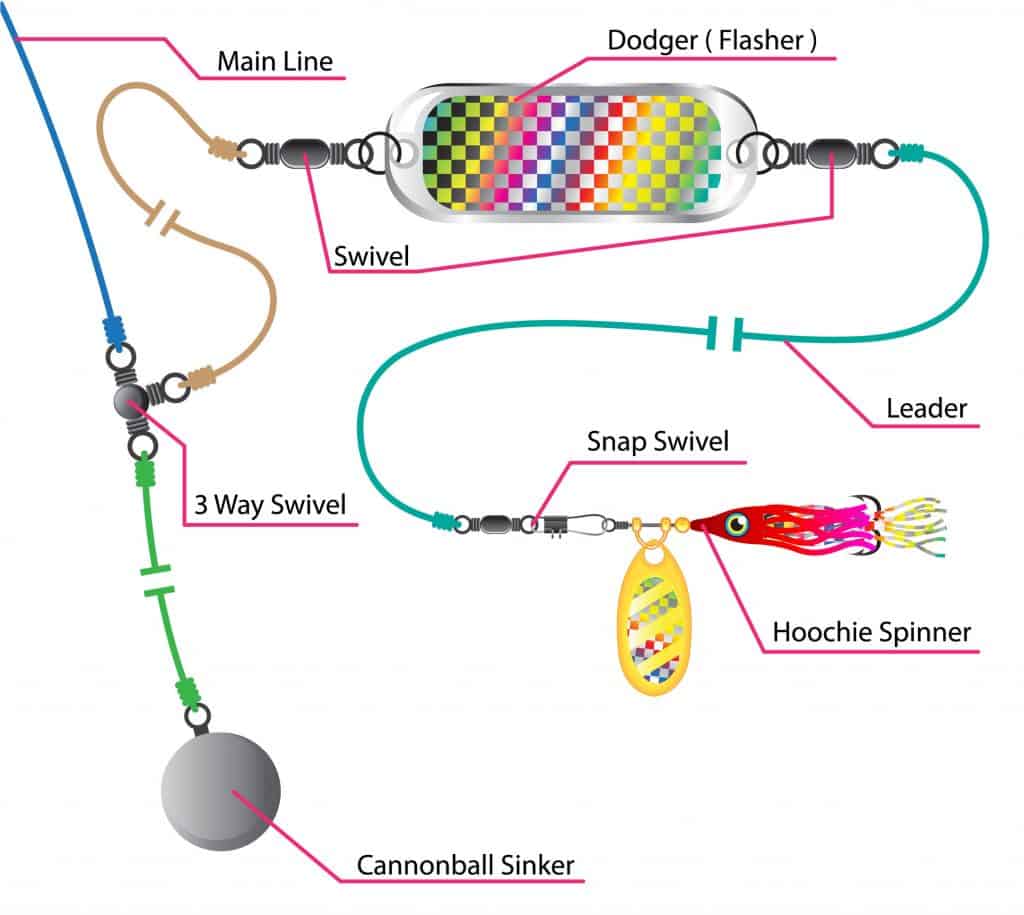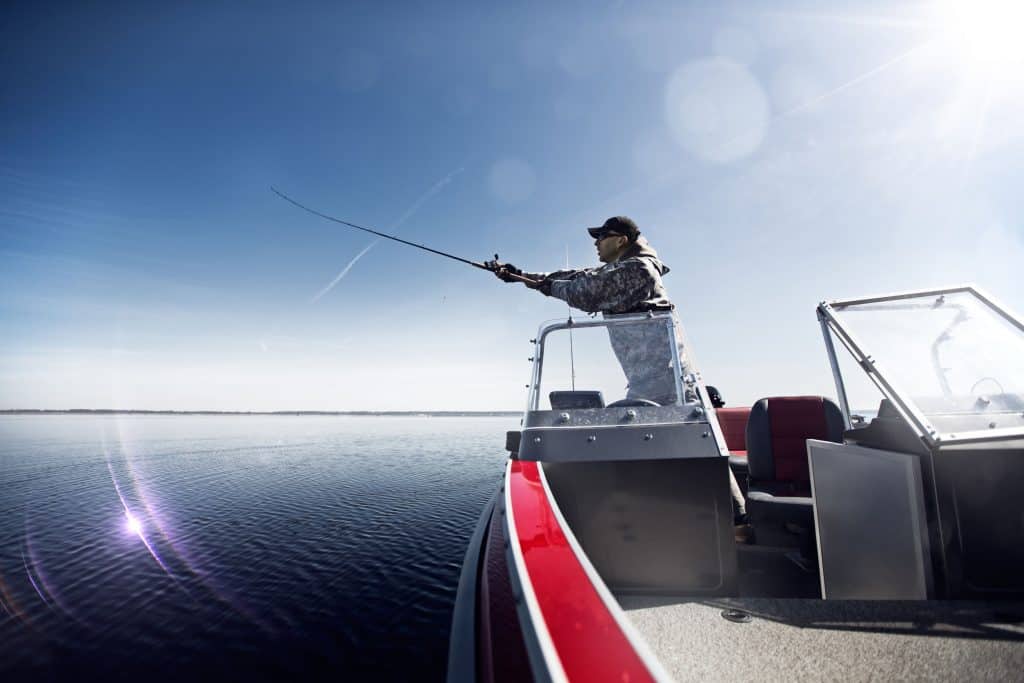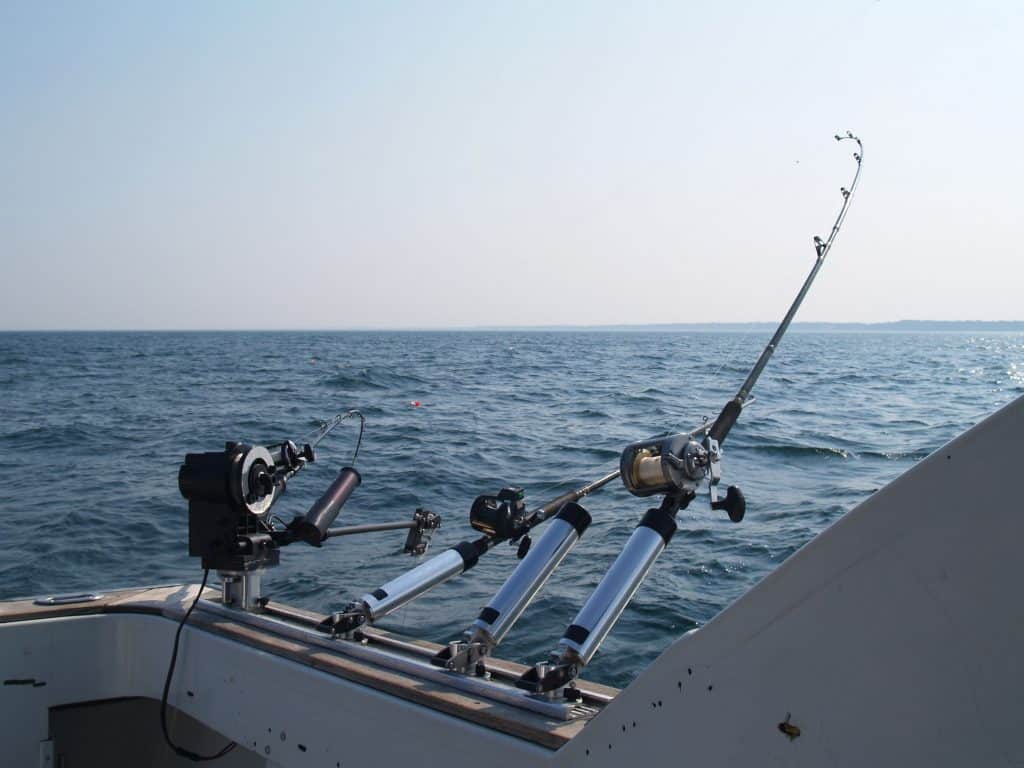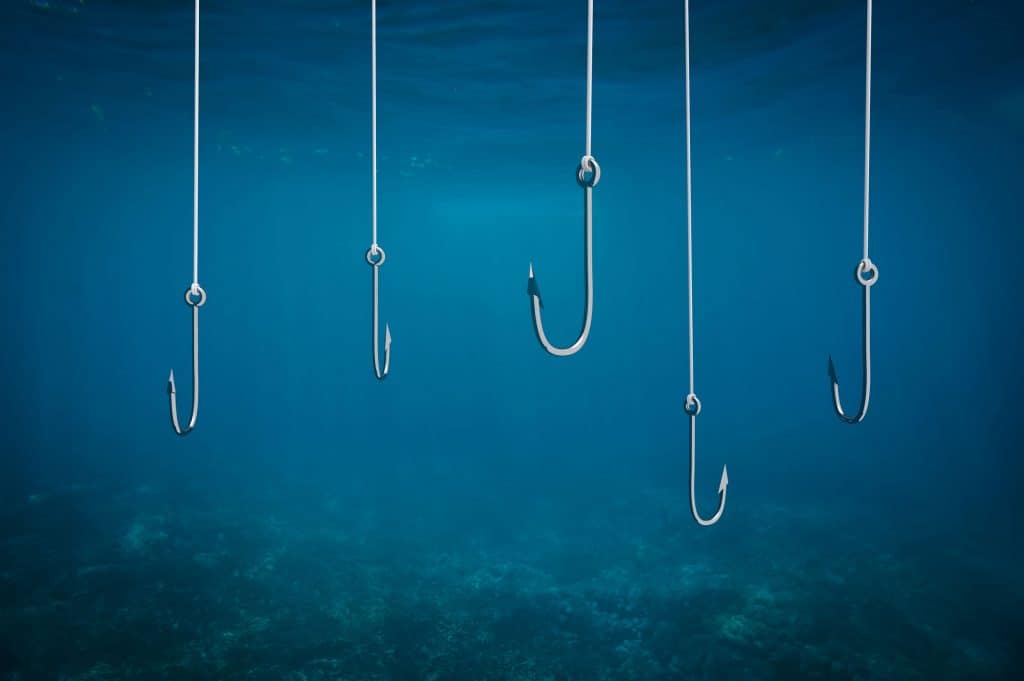
Each fisherman has a finely curated recipe for their perfect fishing setup, which generally varies from each kind of fish to the next. I thought I’d share my absolute best recipe for catching Kokanee Salmon with you all! This has worked for me countless times, and while I’m always open to improving my rig, I haven’t found anything that beats what I’ve got now.
| Equipment | Recommendation |
| Boat | Smoker Craft Freedom 18 |
| Downrigger | Walker Downriggers Lake Master Manual Downrigger |
| Fish Finder | Raymarine Dragonfly 4 PRO |
| Rod | Tica KLEA/KLEB/KLEC/KLED Kokanee Glass Fishing Rod Series |
| Dodger | Shasta Standard Sling Blade Dodger |
| Flasher | Mack’s Lure Flash Lite 4-Blade Series |
| Snubbers | Luhr-Jensen Great Lakes Snubber |
| Hook | Kokabow Double Hook Spinners |
| Bait | Shoepeg Corn |
| Scent | Garlic |
| Net | EGO S1 Genesis |
| Line | 8# Maxima Ultragreen |
Dodger Setup
Attach your flashers to the ball that weighs down your downrigger line. With the kind of flashers I use, which are attached to the ball, I want to keep my dodger and lure decently close to the the flashers, keeping the action together.
I use a line and stacker clip to attach my line to the downrigger cable, making sure I measure out my line correctly. Too long, and the line will trail out too far behind my flashers. Too close, and all the action will be in exactly the same place, which I also don’t want.
Attach the dodger several feet down the line after it passes through the line clip. How far after the dodger you attach your lure us dependant on the kind of lure it is. If there are any attachments that will give the lure its own action, you can attach it farther away. If the lure has no action of it’s own, you’re going to want it closer to the dodger, so there is some transference of movement to the lure and/or bait.
Dodger – Shasta Standard Sling Blade Dodger
The Shasta Standard Sling Blade Dodger is something I found thanks to the internet, and people sharing their success stories. I found a video that I’ll link above so you can see what kind of action this specific dodger gives when it’s being pulled in the water behind your boat.
The dodger is meant to provide movement and a “thumping” noise in the water that makes the fish curious enough to come to investigate. Kokanee salmon are very curious and aggressive fish, so if there’s something out of the ordinary that isn’t obviously a predator, they’ll come to check it out. That’s what you have a dodger for.
As you can see, it’s incredibly smooth, and even in the video, is attracting fish to the bait. Some of the things it’s been advertised to do that I can’t really observe from my boat include smoother action than other dodgers, faster action than other dodgers, and it’s supposed to stop “slinging” once you have a fish on your hook, making it easier to bring your fish in, and enabling you to more accurately feel your fish fighting you.
The number one thing that grabbed my attention about this dodger is the raving reviews it has online. Everyone seems to love this brand and this specific model. If you want to check out some of the things people are saying about this dodger because you’re thinking of giving it a try, just google the name. There seems to be no shortage of good things people have to say, and I personally love it. I’ll always have several in my tackle box, in several different colors.
Downrigger – Walker Downriggers Lake Master Manual Downrigger
Downriggers are an absolute necessity when it comes to fishing for kokanee salmon. Unless you’re ice fishing in the middle of the winter, you’ll want one. I know you CAN catch kokanee without one (like if you have a jigging machine) and that you could probably TECHNICALLY catch them from the shore if the water is cold enough, but those are too many IFS for me. Just shell out the money and buy a downrigger, you’ll be glad you did.
In case you’re a little unclear as to what a downrigger is, or why you should have one, I’ll explain real quick.
Kokanee salmon are a very temperature sensitive fish, which means that they will be living in colder water that’s generally found deeper in the body of water you’re fishing, typically between thirty to sixty feet down. This makes the chances of you catching one just casting your line out very small. Very small. You need to get your tackle and bait down to the fish, which, as I mentioned, is pretty deep. This is where the downrigger comes in. The downrigger gets your gear down deep, so while you troll for the fish, your bait is dragged behind you at the desired depth, hopefully waving your bait right in front of the fish.
I bought the “Walker Downriggers Lake Master Manual Downrigger“. It was around $200, which makes me cringe just a little bit, but it does what I want it to, and I haven’t regretted buying it. I definitely wouldn’t be as successful without it, and it was one of the cheaper models. It is a manual, not electric, which could be considered a downside, but I don’t have any problems with it.
Rod – Tica KLEA/KLEB/KLEC/KLED Kokanee Glass Fishing Rod Series
For fishing kokanee salmon, I use the Tica KLEA/KLEB/KLEC/KLED Kokanee Glass Fishing Rod Series (I had to Google that name to make sure it was right). This rod is absolutely amazing.
I paid around $60 for it, which is part of the reason I love it so much. There are some really expensive kokanee rods out there, and while that generally does mean you end up with a better product, I definitely don’t feel like I traded down in quality for this price I paid. If anything DID happen though, like if heaven forbid, the rod broke or got stepped on by a child, I won’t have just lost hundreds of dollars.
The rod is made out of fiberglass, and it’s super sensitive. I can tell just by watching the tip of the rod if I’m getting hits, which I love. It’s like an early warning system letting me know that I need to get ready to reel my fish in. That being said, even though it is sensitive, it’s super durable, and I don’t worry about it breaking when I’m in the middle of a death match with a kokanee salmon.
It has a cork handle, which I personally love the feel of. It makes the rod feel more secure in my hand, and it reminds me of fishing with my dad when I was little. Aside from loving the personality the cork gives my rod, it also fits perfectly into the stand on my downrigger.
Boat – Smoker Craft Freedom 18′
This is a semi-recent purchase, but my Smoker Craft Freedom 18′ is the best thing I’ve owned for Kokanee fishing (which isn’t hard, I didn’t have a boat before this). It isn’t fitted out with tons of bells and whistles like your more expensive boats are, but it has everything I need, and it can be equipped with extras and bonus equipment if I want it. It’s easy enough to fit with a downrigger, it fits several of my friends, and it isn’t atrociously big, so it’s fairly easy to store.

A downside I could see to this specific boat is the number of seats. It only has two, which could be a problem if you have too many friends, so if you have more than one or two fishing buddies, you may need to reevaluate your friendships. It CAN semi-comfortably fit around six people, so if one friend is too few, you could technically have six, if most of them don’t mind standing the whole time. Or sitting on a cooler.
All that being said, generally, the deciding factor when it all comes down to it is the price of the boat. I got this one in the twenty thousand dollar range, and like I mentioned earlier, while it most certainly isn’t the fanciest thing on the lake, it’s everything I need to go fishing, and I didn’t break the bank when I bought it.
Fish Finder – Raymarine Dragonfly 4 PRO
I mentioned just before when talking about downriggers that kokanee salmon are typically a deeper dwelling fish, which means you can waste a lot of time dragging your line around at a depth where you can’t see if there are actually fish to be caught. You’ll want to have an idea where the fish are, and how deep the fish are.
You can do this in a couple of ways. You can watch the other fishermen and ask the ones who are having success what depth they’re fishing at, which will tell you the depth to fish at, but unless that specific fisherman gives you their spot, that may not be super useful. Maybe you’re anti-social, and don’t want to seem like a creep asking other people questions about their fish. The remedy? A fish finder!
Fishfinders, like so many other things, are one of those things where the kind of money you spend will really impact the success you have and the kind of product you end up with. You’re going to want a fish finder that is powerful enough to get you a fairly deep image and casts a wide cone, to give you the best chance of finding a school of kokanee.
I’ve got the Raymarine Dragonfly 4 PRO. It has WiFi built into it, so I can use it with an app on my phone. It’s got a great screen, gives me a clear image that goes deep enough into the water for me, and it never fogs up. There are definitely fancier ones, so if you’ve got money to burn, get a better one.
This model is around $300, but mine was a Christmas gift, so this is one area where I don’t have to feel guilty about spending money to feed my fishing obsession.
Line – 8# Maxima Ultragreen

I’d never given much thought to my line before I started fishing for fish that could actually break my line, so I tried out 8# Maxima Ultragreen on the recommendation of a friend, and I don’t know if I’ll ever change. The green shade of the line makes it almost invisible to fish, which means they won’t have their attention taken away from your bait and tackle.
I’ve never once worried that my line was about to break, and even though I’ve never used it in anything but open water, it has amazing reviews for toughness, so I wouldn’t feel worried using it fishing shallower water where it would be rubbing against rocks that would wear at it.
Flasher – Mack’s Lure Flash Lite 4-Blade Series
Flashers are meant to work in concert with the dodgers on your line. While dodgers are generally bigger and meant to produce a noise, flashers are there to…well, flash. By spinning and reflecting light from the surface, they flash light deeper in the water, which the kokanee salmon are attracted to.
I’ve been told that the combination of a group of dodgers and flashers mimic a school of small fish, which makes the territorial kokanee angry, and that’s exactly what you want. Mack’s Lure Flash Lite 4-Blade Series is a length of line with four flashers placed equidistant from each other along the length, which, if the rumor is true, could easily be mistaken for a small school of fish.
I enjoy this flasher because it’s fun, and very light, producing a minimal drag on my line, which means it doesn’t make my fight with the fish any more difficult or give me false alarms on my pole. It comes in a variety of colors, so there’s some customization you can mess around with to get exactly what you want.
Snubbers – Luhr-Jensen Great Lakes Snubber
While this isn’t an absolutely necessary piece of gear, like a rod, or fishing line are, snubbers are a great little addition to your setup. You may have read about, or experienced the soft mouths of the Kokanee salmon for yourself, whether you’ve seen the hook tear through yourself, or you’ve been in the middle of a heated battle trying to real in the fish, and all of a sudden, it was gone. The hook probably tore through its mouth, if that has happened to you.
The purpose of the snubber is to prevent that from happening. It helps set the hook, but also takes some of the pressure off the mouth of the fish, lessening the chances of you losing your fish after a hard-fought battle. I use the Luhr-Jensen Great Lakes Snubber. It’s fairly cheap, sold pretty commonly, and seems to be holding up to the water and air well, with no signs of cracking.
I didn’t know this until I had already purchased mine, but apparently, you can make one yourself, instead of purchasing one already made. You need things like rubber tubing, monofilament, things like that. I feel like this may not be something that would actually be cheaper to make yourself since I doubt you can purchase just a few inches of rubber tubing or line. It may save you money over time, but this is a piece of equipment I’ll probably not DIY.
As I said, this isn’t something you NEED, but every time I feel kokanee hit my line, I’m glad I have it. There are few things worse than losing a fish during a fight.
Hook – Kokabow Double Hook Spinners
I feel like most of us assume that a hook will be part of any fishing setup, so why mention the hook specifically? Yeah, a regular silver hook will work, but this is where I kind of let myself have fun. I had no idea before I started Kokanee fishing that there were so many different kinds of hooks!

I’m not talking about shape, or the number of prongs, or anything like that. I’ve had a lot of fun using the Kokabow Double Hook Spinners. As the name implies, it has a spinner attached to it, but it also has several beads, which I can only surmise are meant to reflect light or are in colors that will attract the fish. Definitely something you could make yourself!
For those of us who like night fishing (because none of us are behind on sleep, are we), I’ve had a LOT of fun using glow in the dark hooks. I feel like the super creepy angler fish in Finding Nemo that lured in Dory and Marlin. Now, I honestly don’t know how big of a difference the glow makes, and the glow generally only lasts 20-30 minutes before it has to be “recharged”, but it makes total sense to me that the glow near the hook would attract fish. And, as I said, hooks are just a fun place to have fun. None of the different kinds are really that expensive, so if something doesn’t work, it’s not like you just dropped a paycheck on a dud.
Bait – Shoepeg Corn
Ok, bait. Kokanee is a weird fish. They’re fairly decently sized, but for the most part, they actually really only eat zooplankton. They filter them through their gills. This matters because, with a lot of fish, you fish with bait that resembles the things they have in their diet. With Kokanee salmon, that’s obviously not really feasible. Fortunately for us, Kokanee salmon are aggressive, territorial, and curious, which means that although we won’t be baiting our hooks with zooplankton, there are lots of ways to get them to bite a hook.
You’ll generally want to bait your hook (if you use bait for kokanee, some people don’t) with something you can soak in a scent, which I’ll talk about next. The most popular things to use are maggots, shrimp, or shoepeg corn. The maggots or shrimp can be real or fake, but having them be some weird, bright fluorescent color is a good idea. I use shoepeg corn. This isn’t the corn that you just buy in cans and feed to your kids, you’ll have to buy this online or from a fishing shop.
Kokanee salmon LOVE this stuff, and I’m most certainly not the only person that uses it. Many, if not most kokanee fishermen do. If you do use this, unless you’re soaking it in a different, scent, don’t open it until you’re about to use it. Keep it tightly sealed so none of the smell or concentrated taste gets out. Open it when you’re ready to bait your hook, not before.

Scent – Garlic
Scent plays a HUGE part when you’re fishing for Kokanee salmon. They’re a very scent sensitive fish, so it can be used to draw them in, and make them mad. While we can’t know for sure, different fisherman claim different scents inspire different moods and behavior in the salmon.
These scents can either be purchased or made from different ingredients and things you have around the house and in your pantry. I’ll go over my favorites (which are ones you can make at home), and then store bought ones my friends have used with success.
I’m big on saving money, so if I can make something as opposed to purchasing it for more than it would cost to make, I’m going to make it. I found ALL of these ideas online, so peruse the internet and try out new things. Lots of people are open to sharing what has made them successful. Garlic is one of those scents. Most kokanee fishermen and women say that garlic makes the kokanee salmon mad, and while I can’t vouch for how the fish is feeling, I can say that it probably hates it.
I mentioned earlier that, more than likely, you generally won’t be fishing with anything that resembles anything in their normal diet, so the chance of them striking at your hook because it has something they like is small. Kokanee salmon are an incredibly curious and aggressive fish, and we use this to our advantage. You don’t have to use a scent that they like. Using a scent that makes them mad will work just as well.
Homemade Scents
- Garlic. We think this makes them mad, but regardless of what it does to their brains, it makes them strike your scented bait. It can be made at home by adding garlic powder, garlic salt, or some minced garlic to your can of bait, whatever it is. Keep in mind that garlic will get stronger with age, so don’t add a ton. You want to bring the fish in, not pollute a lake.
- Anise extract. I honestly don’t know why this one works, if I were a fish, I’d stay the heck away. I guess kokanee must be fans of black licorice. If I had to guess, I’d say this one is such a hit because it’s such a STRONG scent/ flavor. Similarly to the garlic, add the anise extract to the can of bait and let it marinate. I use 7 drops, but you can figure out what works best for you.
- Tuna juice. Who even knows why this works. Kokanee salmon don’t eat tuna. They don’t really even eat other fish. Sometimes they’ll eat tiny grubs or shrimp. But shoepeg corn soaked in tuna juice? They love it. Same drill as with the anise and garlic, open a can of tuna and drain the juice into your can of bait.
- Additional ideas the internet has given me that I HAVEN’T tried yet are maple syrup, strawberry extract, and vanilla extract.
Store bought Scents
I’ve only ever used homemade scents, but my buddies use some of these and have seen success with them so I figured they deserved at least an honorable mention.
- Salmon Egg Juice
- Krill Oil
I don’t have as much to say about these since I haven’t used them myself, but a quick internet search will show you that they’re popular, and they’re popular for a reason. I’m just a cheapskate, and I’m not going to spend money where I don’t have to.
Net – EGO S1 Genesis
I’ve owned a number of nets over the years, and I’m SO glad I found this one. It’s easily the best one I’ve ever owned. When you think about nets, what are the problems that we generally have? Hooks getting caught in the netting, or the netting getting caught on the brush while you’re walking to your secret fishing spot, right?
Dropping the net into the water and watching it sink is a personal painful memory. I specifically remember the net my dad would use when he would take me fishing as a little kid because my hooks were always getting caught in the netting. It was metal, with bright, neon green netting. I remember the netting because it was the part of the net I could still see while it sank after I dropped it in the water. Bless my dad’s heart, he told me that it was a good excuse for him to buy a new net.
While I may love this piece of equipment because it resolves so many of my childhood traumas, with this net, you won’t have any of those problems. The EGO S1 Genesis has rubber netting, which means the netting never gets caught on my hooks, or if I’m walking with it, it never gets caught on any of the trees or bushes either.
Worried about you or your kid dropping your stuff in the water? Don’t be! This net floats. It’s made with floatation material near or around the basket part of the net, depending on the model you buy from this brand. Mine also comes with a telescoping rod, so I never have to worry about overextending and falling out of my boat, or trying to reach the net too far out and dropping it that way. It’s always the length I need it to be.
Tips and Tricks
So, as a disclaimer, I haven’t tried all these myself. Some of these things are tricks my friends have told me about, and others are ones I’ve read about as I’ve researched different ways to catch more kokanee.
An example of something I haven’t tried yet, but I want to, is electricity. I’ve read quite a bit about how kokanee are attracted to a positive current in the water, and repelled by a negative one. With the right equipment, you can apparently use your boat and downrigger to get a positive charge into the water around your gear, attracting fish. Unfortunately for me, but fortunately for the fish, while the idea of possibly catching more kokanee sounds great, I don’t really want to spend the money the get all that working.
Another tip a friend of mine swears by, but I remain skeptical of, is trolling parallel to the shore. According to him, the fish swim parallel to the shore. I’ll be honest, I haven’t paid much attention to the different rates of success I’ve had when I troll parallel as opposed to perpendicular. Or diagonal. If you have a fish finder, I don’t think that should matter as much, since you’ll already know where the fish are.
